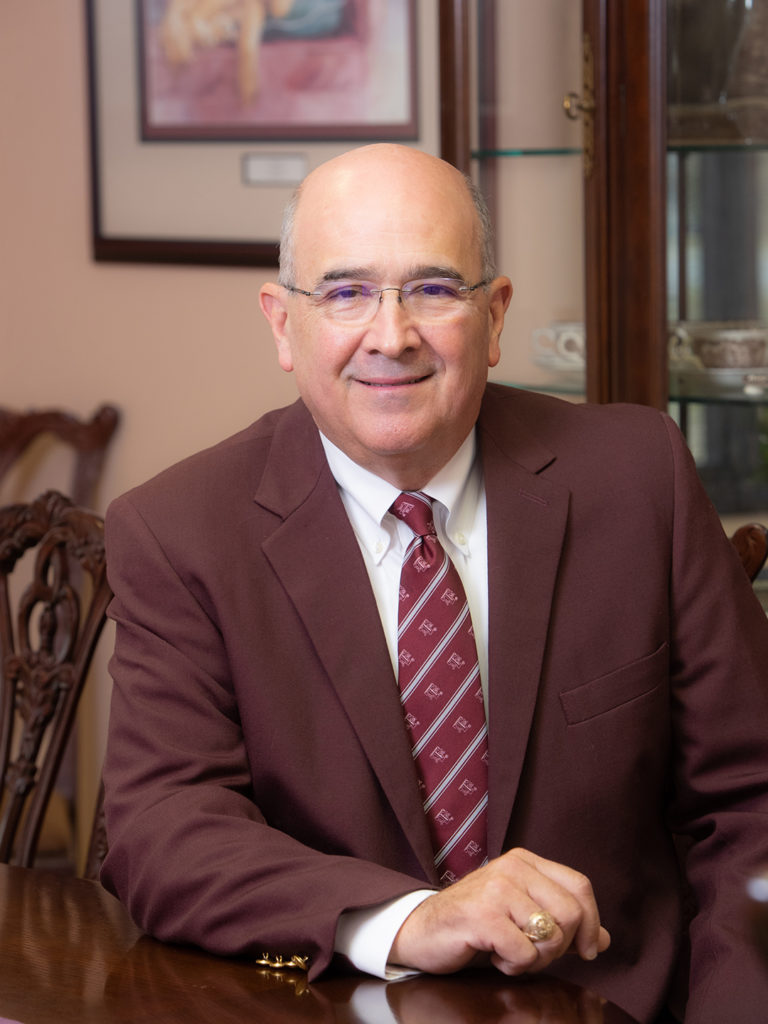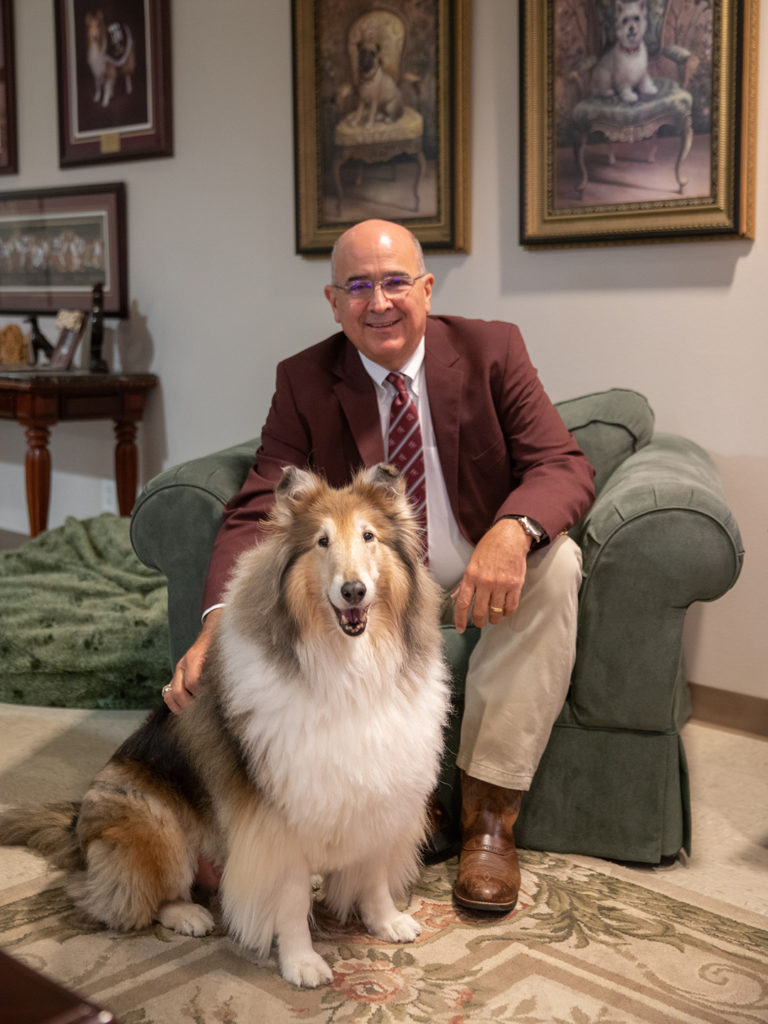Miller Begins Appointment As Stevenson Center Director, Continues Center’s Legacy
Story by Rachel Knight '18, VMBS Communications

Dr. Sam Miller ‘91 begins his workday living an Aggie dream. As he passes through the front door of his office, Reveille IX greets him with an air of excitement fit for a retired queen of Aggieland.
In September, Miller assumed the role of director of the Stevenson Companion Animal Life-Care Center, a facility on the Texas A&M University campus in which a team of staff and students provides for the physical, emotional, and medical needs of companion animals whose owners are no longer able to provide that care.
Both Miller and the Stevenson Center are one-of-a-kind gems in the field of veterinary medicine.
Miller first came to Aggieland as a student. His grandfather attended Texas A&M but only had enough money for one semester. He was on Texas A&M’s football roster for that one semester with E. King Gill, the man who inspired the 12th Man tradition. His father attended the University of Texas in Austin.
“I grew up bleeding orange and white, a die-hard t.u. fan, and thought that was the only school for me,” Miller shared. “During my time in FFA in high school and while working at a veterinary clinic, I realized I wanted to become a veterinarian. At that point, there was really no doubt that if you want to be a veterinarian, you go to the best school and that is Texas A&M. It was probably one of the best decisions I’d ever made.”
After graduating from Texas A&M, Miller worked at Nolana Animal Hospital in McAllen, in the Rio Grande Valley, for three years.
“I worked under two great veterinarians, one of whom was a surgeon, and they definitely shaped my skills as a veterinarian,” he said.
When Miller and his wife decided to move closer to home to raise their family, he joined a solo practitioner at the Village Veterinary Clinic in Houston and was offered an opportunity to buy into the practice within a year. He became sole owner of the clinic in 1998.
“My goal was to create a practice environment in which we focused on developing long-term relationships with our clients while offering the best medicine possible for their pets,” Miller shared. “Often, in the hectic pace of day-to-day practice, we don’t realize the impact we have on our clients, but that impact became readily apparent when I announced my retirement earlier this year. I received numerous calls and letters from long-time clients who expressed their deep appreciation for what I had done for them over the years.”
Now at the Stevenson Center, Miller brings his exceptional experience practicing veterinary medicine and running a successful clinic, as well as his leadership experience in organized veterinary medicine demonstrated through his veterinary response work in the aftermath of Hurricane Ike, in the Texas Veterinary Medical Association, and in legislative advocacy.
“What has surprised me the most is the impact that we as veterinarians have on our clients,” Miller shared. “That carries over well into my work here at the Stevenson Center. We’ve had individuals who are going through the will-making process or estate planning for the first time. Their top priority is, ‘What am I going to do with my pets?’ It’s a very easy transition for me because I realize how important that bond is and how important this facility is to helping give them that comfort.”

The opportunity to form new bonds with pets and their owners at the Stevenson Center is ultimately what brought Miller back to Bryan-College Station.
“I have long been aware of the great works of the Stevenson Center,” Miller explained. “When I heard of Dr. Presnals’s retirement, I realized this was the perfect opportunity to slow down from the hectic pace of practice, yet continue in the profession working with folks who have a strong connection with their pets—not to mention that I loved the thought of getting back to Texas A&M.”
Miller said the university and the School of Veterinary Medicine & Biomedical Sciences (VMBS) have changed since he was a student. Technological advancements and the updated DVM curriculum are among the changes he’s noticed since returning to Aggieland.
“The recent curriculum change focused more on clinical skills has better prepared students to be practice-ready after graduation. Their learning experiences are much better than ours were,” Miller recalled. “In fact, when I was working at the Village Veterinary Clinic, we hired a young lady who was one of the first graduates of the new curriculum, and her clinical skills were phenomenal.”
Miller’s aspirations for the Stevenson Center align well with the VMBS’s mission to enhance animal and human health through transformational education, discovery and innovation, patient care, and public service that impacts our diverse and evolving world.
“When people see the value in this facility, they see the honest work that we do because we care for these pets,” he said. “There’s a strong bond, and then the fact that we’re associated with one of the best veterinary schools in the country gives us an easy opportunity to promote not only what we’re doing here, but also what is happening at the veterinary school.”
During his time serving the Stevenson Center, Miller will oversee the final expansion of the center’s building. He’s already made quick friends with the 34 residents who currently live at the center and has aspirations to develop even more relationships with pets and their owners who seek the best veterinary care for their pets.
“It is truly an honor to have been chosen to continue the legacy that is the Stevenson Center.” Miller shared. “In the short time I have been serving as director, I have come to realize there is an increasing demand from pet owners to ensure there is a means to provide lifelong care for their pets, should the need arise.
“It is my vision that the Stevenson Center increase its national recognition as a one-of-a-kind facility and, more importantly, serve as an inspiration for other universities and organizations to establish similar programs offering this type of long-term care to service the increasing demand from the pet-owning population.”
###
For more information about the Texas A&M College of Veterinary Medicine & Biomedical Sciences, please visit our website at vetmed.tamu.edu or join us on Facebook, Instagram, and Twitter.
Contact Information: Jennifer Gauntt, Director of VMBS Communications, Texas A&M College of Veterinary Medicine & Biomedical Sciences, jgauntt@cvm.tamu.edu, 979-862-4216


